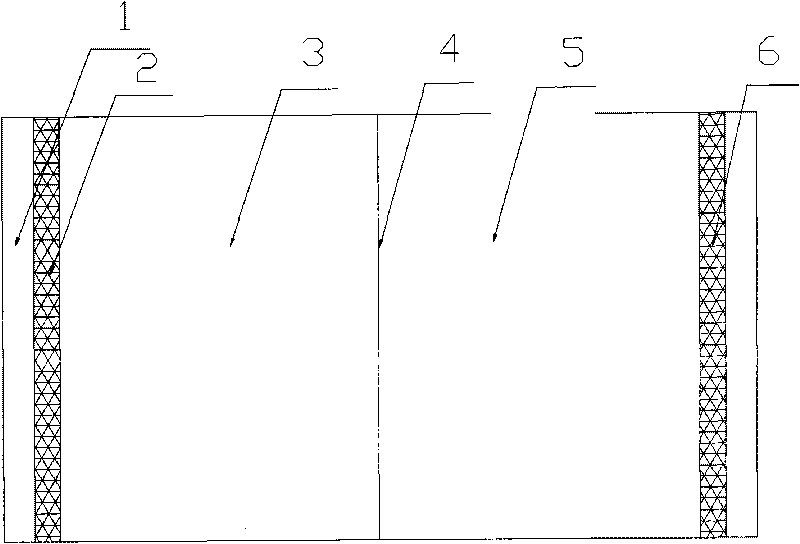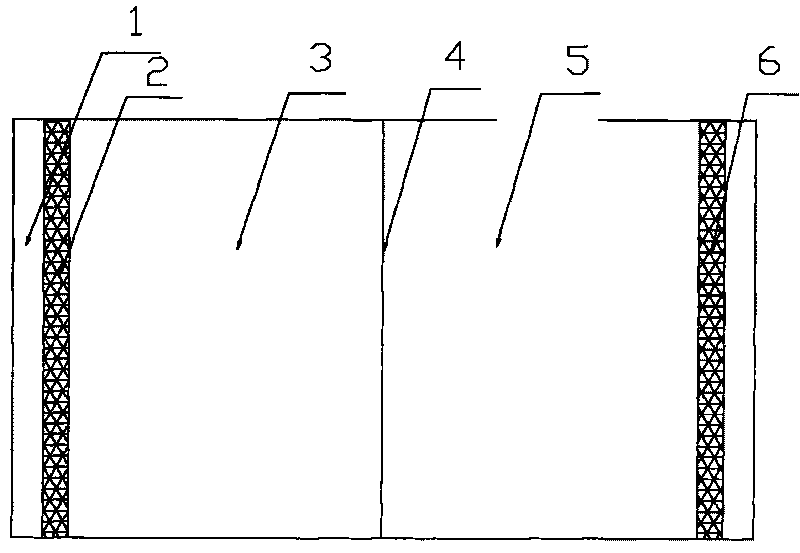Algous cathodal double-chamber microbiological fuel cell and application thereof
A fuel cell and microbial technology, applied in the algae cathode double-chamber microbial fuel cell and its application field, can solve the problems such as the limitation of cathode electricity production, and achieve the effects of reducing processing costs, good economic benefits and application prospects
- Summary
- Abstract
- Description
- Claims
- Application Information
AI Technical Summary
Problems solved by technology
Method used
Image
Examples
Embodiment 1
[0025] The anode chamber 3 of the dual-chamber microbial fuel cell is inoculated with anaerobic granular sludge to allow electrogenic bacteria to attach to the anode 2 . Add electrode solution (containing NaH 2 PO 4 .2H 2 O 5.6g / L, Na 2 HPO 4 .12H 2 O 6.07g / L, NH 4 Cl 310mg / L, KCl 130mg / L and trace elements). Sodium acetate was used as the simulated wastewater carbon source, and was added to the anode chamber 3 to make the initial COD 1000mg / L. Add algae samples (mainly containing Microcystis and Chlorella) in the eutrophic lake to the cathode chamber 5, so that the chlorophyll content of the suspended algae in the electrode solution in the cathode chamber 5 is 1 mg / L. The light intensity is 2000lx. In the stable power generation period, the maximum voltage drop of the battery on an external 1000Ω resistor is 221mV, and the power density is 9.77mW / m 2 . The anode COD degradation rate can reach 100%.
Embodiment 2
[0027] The anode chamber 3 of the dual-chamber microbial fuel cell is inoculated with anaerobic granular sludge to allow electrogenic bacteria to attach to the anode 2 . Add electrode solution (containing NaH 2 PO 4 .2H 2 O 5.6g / L, Na 2 HPO 4 .12H 2 O 6.07g / L, NH 4 Cl 310mg / L, KCl 130mg / L and trace elements). Sodium acetate was used as the simulated wastewater carbon source, and was added to the anode chamber 3 to make the initial COD 1000mg / L. Add the Microcystis suspension into the cathode chamber 5, so that the chlorophyll content of the suspended Microcystis in the electrode solution in the cathode chamber 5 is 1 mg / L. The light intensity is 2000lx. In the stable power generation period, the maximum voltage drop of the battery on an external 1000Ω resistor is 199mV, and the power density is 7.92mW / m 2 . The anode COD degradation rate can reach 100%.
Embodiment 3
[0029] The anode chamber 3 of the dual-chamber microbial fuel cell is inoculated with anaerobic granular sludge to allow electrogenic bacteria to attach to the anode 2 . Add electrode solution (containing NaH 2 PO 4 .2H 2 O 5.6g / L, Na 2 HPO 4 .12H 2 O 6.07g / L, NH 4Cl 310mg / L, KCl 130mg / L and trace elements). Sodium acetate was used as the simulated wastewater carbon source, and was added to the anode chamber 3 to make the initial COD 1000mg / L. The chlorella suspension is added to the cathode chamber 5, so that the chlorophyll content of the suspended chlorella in the electrode solution of the cathode chamber 5 is 1 mg / L. The light intensity is 2000lx. In the stable power generation period, the maximum voltage drop of the battery on an external 1000Ω resistor is 208mV, and the power density is 8.65mW / m 2 . The anode COD degradation rate can reach 100%.
PUM
 Login to View More
Login to View More Abstract
Description
Claims
Application Information
 Login to View More
Login to View More - R&D Engineer
- R&D Manager
- IP Professional
- Industry Leading Data Capabilities
- Powerful AI technology
- Patent DNA Extraction
Browse by: Latest US Patents, China's latest patents, Technical Efficacy Thesaurus, Application Domain, Technology Topic, Popular Technical Reports.
© 2024 PatSnap. All rights reserved.Legal|Privacy policy|Modern Slavery Act Transparency Statement|Sitemap|About US| Contact US: help@patsnap.com









